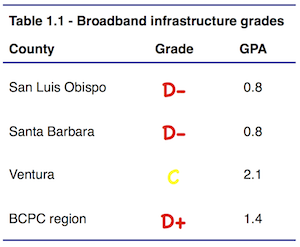
Click for the details.
The low water mark for broadband on California’s central coast is the Monterey-San Luis Obispo county line. As you move north or south from there along the route of the historic El Camino Real, broadband infrastructure gradually gets better, before hitting high water marks in Silicon Valley and Ventura County.
That’s the top line finding from a study I recently completed for the Broadband Consortium of the Pacific Coast. Northern SLO County has an uneven mix of legacy Verizon – now, Frontier – and AT&T systems, some lacking even 1990s grade DSL service, plus some below average Charter cable systems along a narrow corridor either side of U.S. 101. Charter’s claimed download speed – 100 Mbps – is typical for cable systems in California, but its 5 Mbps upload speed misses the mark.
As you come south into the City of San Luis Obispo, AT&T predominates and service improves somewhat, with more ADSL2-based Uverse systems present.
Moving into Santa Barbara County, it’s all ex-Verizon on the telco side. Except for a few pockets of fiber-to-the-home FiOS service in new developments, the picture is pretty bleak. Not a single former Verizon copper system in California – central coast or elsewhere – meets the CPUC’s minimum standard of 6 Mbps download and 1.5 Mbps upload speeds. Some manage to meet or exceed the download benchmark, but the fastest upload speed that Verizon supported on copper was 1 Mbps. The northern half of the county is Comcast territory, the southern portion, including the City of Santa Barbara, is served by Cox. Both deliver average upload and download speeds for Californian cable systems.
Ventura County has an interesting mix of service providers and technology. Aside from a small pocket of Cox service in the north, the county is, or rather was, served by both Time Warner, which more or less meets the California average, and Charter. Charter owns it all now, having completed its purchase of Time Warner in May. Telephone systems are split three ways – AT&T copper, ex-Verizon copper and FiOS. As you get closer to Los Angeles County, the mix is excellent – predominantly Time Warner cable and FiOS. Where it’s only Charter and ex-Verizon copper, it’s not so good. Areas with AT&T infrastructure – more ADSL2 and VDSL systems are present – fall in between.
Overall, SLO and Santa Barbara counties get a “D-” on the A to F grading scale we originally developed for the East Bay Broadband Consortium. Cities and unincorporated communities in those two counties more or less hover around that mark. Ventura County, on the other hand, earned a strong “C” overall, with several cities and unincorporated communities ranking in the “A” and “B” range.
Full report card details are in the report, along with an assessment of wireline and wireless broadband infrastructure in the three counties. The report also contains the first run of a new analytical tool – Star Ratings – that zooms in on commercial and industrial broadband infrastructure. More on that later.
Broadband Analysis and Planning, Broadband Consortium of the Pacific Coast, Final Report, 11 April 2016
Broadband Analysis and Planning Broadband Consortium of the Pacific Coast Update, 30 June 2016
Star Rating maps – San Luis Obispo County
Star Rating maps – Santa Barbara County
Star Rating maps – Ventura County
